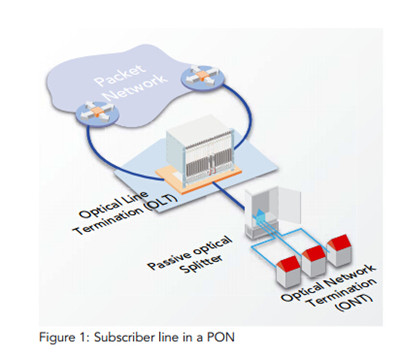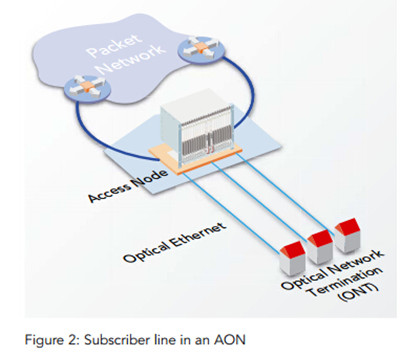Deciding Between Passive Optical Networks and Active Optical Networks
petak , 02.09.2016.The FTTH solution is regarded as the best option with respect to the transmission quality and the bandwidth. The deployment of FTTH (Fiber To The Home) access networks has gone through a long way before subscribers use fiber cables instead of copper lines to achieve broadband Internet access. FTTH is a form of fiber-optic communication delivery with fiber extending from the central office to the subscriber's living or working space. The FTTH network can be directly laid by using active optical network (AON) or passive optical network (PON). Each design offers a way to separate data and set it upon its intended route to arrive at the proper place. These two networks comparatively have their advantages and disadvantages, which will be illustrated in the following article.
Passive Optical Network
A passive optical network (PON) is a point to multi-point (PMP) optical network that only uses fiber and passive components like optical splitters rather than active components (amplifiers, repeaters, or shaping circuits). That is to say, a passive optical network shares fiber optic strands for portions of the network. In passive optical system, a single fiber from a central office optical line terminal (OLT) is connected to optical network terminals (ONTs) or optical network units (ONUs) at customer premises. An optical splitter, also called PON splitter, is either fitted in or outside the subscriber’s premise to separate to collect optical signals and distribute the signals to users.

An OLT shown in the above image terminates the optical signals and distributes them to as many as 16 to 128 customers per fiber line. An optical network unit (ONU) terminates the PON at the customer’s home. The ONU usually communicates with an optical network terminal (ONT), which may be a separate box that connects the PON to TV sets, telephones, computers, or a wireless router. Note that the ONU and ONT are basically the same device.
Active Optical Network
The AON arrangement is a point-to-point structure (PTP), meaning that each user has his own dedicated fiber optical line terminated on an optical concentrator. In an active optical system, environmentally electrical switching equipment are deployed, such as a router or a switch aggregator, to manage signal distribution and route data to proper places. Additionally, AON is perfect for high-profit end customer segments, such as business customers, multi-dwellings, universities, local authorities, etc.

Comparison of the Technologies AON vs. PON
The key technical difference between active and passive access technology is that a passive splitter is used for passive optical networks. The splitter is basically a kind of multi-mirror that distributes the optical signal for the subscriber line to fiber optic routes without any electrical current. Besides, PON is efficient since each fiber optic strand can serve up to many users. On the other hand, because the bandwidth in PON is not dedicated to individuals, it is more difficult to figure out failures when disturbances of fibers occur. The share of fiber optic strands for portions of the network needs PON subscribers to be geographically closer to the central source of the data, likely that subscribers enjoy a slowdown data transmission with a distance limitation up to 20 km.
As for AON subscribers, the bandwidth in each port is dedicated to each individual without sharing of it. Thus, higher bandwidth per port is possible through AON network. In addition, because of its dedication to specific individual, it is easier to detect fiber faults or problems in case of AON. However, an AON system requires active equipment to manage signal transmission, which means power supply and potentially higher costs.
When deciding between a PON or an AON, it is important to consider what services are going to be delivered over the network, the overall network topology and who the primary customer will be. For example, radio frequency video services will be deployed, then a PON is typically the only practical solution. If all services are Internet Protocol-based, however, either a PON or an AON could be appropriate. If there are longer distances involved and providing power and cooling to active components in the field could pose a problem, then a PON may be the best choice. Alternatively, if the target customer is commercial or if the project involves multiple dwelling units, then an AON may be a better fit.
Conclusion
There is no one technology that can apply in all cases. Basically passive optical networks are a better choice for network operators who want to supply a very large number of subscribers. While the active optical technology is more suitable for private network operators, that either lay their own fiber optic lines. Besides these two network versions, EPON and GPON are popular versions of PONs. These short-haul networks of fiber-optical cable are used for Internet access, voice over Internet protocol (VoIP), and digital TV delivery in metropolitan areas. FS.COM is a top manufacturer for optical products, such as DAC Twinax cables (SFP+ Cables, XFP Cables, CX4 Cables, Infiniband Cables, etc) and optics transceivers, including (QSFP+, SFP, SFP+, XFP, X2, XENPAK, SDH, Bidi), OADM/MUX/Demux, Fiber Optic Patch Cords (LC-SC fiber cable) and Fiber Optic Components, etc.
Oznake: Pon, AON, FTTH, fiber cables, Passive Optical Networks, Active Optical Networks
komentiraj (0) * ispiši * #
